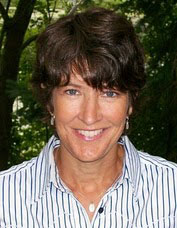Book Titles, Back Cover Copy, & Author Promotion: Tips from Susan Kendrick
 One question we get a lot is: how do I choose a winning book title? Another is: how do I write my back-cover copy/synopsis? And what are the most effective ways to market my book?
One question we get a lot is: how do I choose a winning book title? Another is: how do I write my back-cover copy/synopsis? And what are the most effective ways to market my book?To help you answer these questions, we've invited Susan Kendrick to share her expert advice. There are some wonderful tips and how-tos in this interview that you can apply right away!
Susan Kendrick and Graham Van Dixhorn are partners at Write To Your Market, Inc. They specialize in creating bestselling book covers and business brands--book titles and subtitles, back-cover sales copy, testimonials, business names and taglines, and other pivotal branding and marketing tools. Their clients win major book awards and are featured in The New York Times, L.A. Times, and U.S.A. Today, and appear on national TV talk shows, including The Today Show. But maybe more importantly, Susan and Graham help these authors and experts package their message so that it makes a difference in the world. To learn more, visit www.WriteToYourMarket.com or www.BookCoverCoaching.com.
WOW: Welcome to The Muffin, Susan! Thank you for taking time to share your tips with our readers today. Let's start off by finding out what you do. What services do you provide for authors?
Susan: Thanks for having us! Graham and I create bestselling book titles and subtitles, back cover positioning and sales copy, business names and taglines, media kits, and speaker materials--the tools you need to create and grow a powerful brand for you, your message, and your business.
By doing this, we provide welcome relief for authors whose job it is to be expansive on their topic. Whether you are in the idea, planning, writing, or editing stage of your book, all your focus is on creating a story or message that will speak to people. The job of your book cover, on the other hand, is to take all that you are creating and condense it to the few words that will sell your book. It's writing, but a different kind.
What Graham and I do is interview you, listen to your ideas, and explore your manuscript to capture the highlights that will make you stand out from the crowd and appeal to the people you want to influence most--your readers. You're creating this book for them; you want to make sure they "get" what's in it for them. We also help you position your book to take the lead in your market, so that you are perceived as the expert not only to your readers, but to book reviewers, the media, joint venture partners, and other decision-makers.
WOW: That's a good point and one we often forget while we're writing. We need to think about positioning our book not only for our readers but for the media as well. Another super important issue that authors often ask about is how to choose a book title. What are some things authors should consider when deciding on a working title? And what makes for a winning title?
Susan: First, understand the purpose of a good working book title.
Just as there is expert status associated with being the author of a published book, there is similar status involved in getting out there with news of your "forthcoming" book. Using a good working title to promote your book while you are writing it does several important things.
- A good working book title enables you to talk about your "forthcoming" book in a concrete way, in your emails, on your blog, on your website, in speaking presentations, and through your consulting.
- In this way, it lets you start building a loyal following for your unique ideas and approach to your topic.
- A good working title can also help you reach out to joint venture partners who will ultimately be very important to your promotion and sales efforts.
- In fact, since you are still writing the book, you have the flexibility to mention or quote these experts in your book, a great incentive for them to get behind you and your message.
What makes a winning final title and subtitle?
Use this quick-start checklist to see if your working book title measures up or if you need to either rethink or fine-tune it:
- Your title or your subtitle contains a keyword or keywords related to your topic
- The title is easy to say, hear, remember, and talk about
- Your book title is clear and concise, i.e. no one who hears about it or sees it, regardless of their background, will go, "Huh?"
- The title stands out from other books on this topic because of some unique feature or benefit
- It is not already taken--book titles can't be copyrighted, but you don't want your book confused with another one out there
- Experts in the area of book covers and book marketing give you a thumbs up
- It will give you the flexibility to create a series of related books, products, and services
- Your book title captures the attention of your target audience, which you can determine either by a focus group or online tools like Google AdWords
- Your book title creates a defining brand that will grow your reputation and your overall business
Here are a few basic rules to keep you on track:
- Decide what to say, then how to say it
- Choose clarity over cleverness
- Keep it short
There are numerous strategies and techniques for creating book titles. Just a few approaches include the following:
Look to Your Book (a chapter title, for example, may yield a winning title)
Ex: How YOU™ Are Like Shampoo, by corporate branding expert Brenda Bence
Be a One-Word Wonder
Ex: Blink, by Malcolm Gladwell
Create a Twist on a Familiar Phrase
Ex: Squeaky Green, by Adam Lowry and Eric Ryan, founders of Method cleaning products
Coin a New Term
Ex: Freakonomics, by Steven Levitt and Stephen Dubner
Use Four-Letter Words
Ex: Mojo Mom, by Amy Tiemann
Ex: Eat This Not That, by David Zinczenko
Be the Obvious Expert
Ex: Big Book of Parenting Solutions, by Michelle Borba
Ex: The Self-Publishing Manual, by Dan Poynter
Be compelling or Controversial
Ex: The Four-Hour Work Week, by Tim Ferriss
WOW: Excellent points, Susan! You've given us a lot to think about. Now, back cover copy is also equally important because it must convey the contents of the book in such a short word count. What are some tips for writing and paring down a synopsis?
Susan: One word--positioning. Think of positioning as where your book stands in relation to three things: your readers, your market, and your competition. Then, take a more active role. Use this information to decide what you will say about your book to "position" it in the best possible light. Your back cover does not give you a lot of room to work, so get to the point and be clear, concise, and compelling. Decide what needs to be said, then decide how to say it in the most concise, compelling way possible.
Here are 7 positioning questions to get your creative juices flowing:
1. How does your book address your readers' wants, needs, hurts, hopes, or deepest desires?
2. What do your readers already know about your topic and what do you bring them that's new?
3. What differentiates you and your message from similar books already on the market--what's unique about your ideas, perspective, approach, process, focus, experience, background, etc. In other words, why you and not someone else or some other book?
4. Are you a "first" or "only" in what you bring to this subject or some aspect of this subject?
5. Do you fill an important gap in the information available on this topic? What's been missing that you address?
6. What else makes you stand out in a crowded market, or are you able to create a new niche and dominate it, right from the start?
7. And, most importantly, what will your audience get from your book that they can't get anywhere else?
Your back cover copy then becomes the foundation of your entire marketing campaign, in print and online. You'll use this copy as your website content, on your blog, in articles and press releases, proposals to distributors, pitches to the media, corporate sponsors, joint venture partners, and anyone else who might be interested in buying or selling your book or product.
WOW: Wow, it seems that if you get your back cover copy right, it can do a lot for you! So, do you design book covers as well? Or do you work with designers? How does the process work?
Susan: We do not do the design. We specialize in the words that brand and promote your book, so that even if you have a cover that is designed typographically--that is, with just that billboard look of Blink, Switch, and others--your message still comes across loud and clear. We do, however, work closely with a handful of designers we refer our clients to, and their work is very impressive.
The process is that you first develop the front cover copy--title and subtitle, series name if appropriate, high-end testimonial, and any other front cover copy. Then you take this to the book cover designer for the visual effects that make your brand really pop--on the shelf and online. Then, it's the same with the back cover, spine, and flaps of your books if a hard cover--copy then design.
For more details, you can download a free copy of our Book Cover Timeline on our home page here.
NOTE: Be aware that there is a big difference between a graphic designer and a book cover designer. Hire someone who knows the industry and understands all the subtleties of designing book covers that sell.
WOW: Marketing a book these days involves so many different elements: a website, blog, social networking, media kit, and so forth. If an author has a limited budget, where should she start? And what is the one thing she should definitely spend her money on?
Susan: That's a great question. In fact, we regularly check in with our authors to ask this same question and to see which marketing outlets are working best for them. I did a couple of recent blog posts on this because this is one thing new authors really want and need to know--what really works?
The two authors we interviewed include one who has sold over 150,000 copies of his book since 2001, and one who released and began marketing her book last summer. Overwhelmingly, the responses we get from authors in general and these two in particular are very much the same. You can see the details on our blog, but here is the list in order of results for the book that has sold 150,000 copies:
- Speaking
- Giving Away Books to Movers and Shakers
- Becoming Your Own Publicist
- Selling Books to Direct Sales/MLM companies
- Selling Foreign Rights of Book
Susan Berg, the author of Choose on Purpose for Twentysomethings, released her book with very good results in the first three months by also focusing on public appearances. She also credits book reviews with jumpstarting interest in her book. From a review by Library Journal, she got invited to do a national webcast with the American Marketing Association (AMA), which resulted in a Twitter group following as well as inquiries for follow-up materials and a request to be a guest blogger.
WOW: Those are great suggestions. What about a "squeeze page?" What is it, and do you think this type of marketing is still effective?
Susan: Absolutely! It is the first thing I look for when we are asked to do a critique & consultation of an author's website. Also called a "name-capture," this technique is a way to get visitors to your website to give you their name and contact information in exchange for something you give them. This can be a free excerpt from your book or some other useful or interesting download related to your topic or area of expertise.
The point is that when you have someone's email address, you can stay in touch with them about what you offer that may interest them. People visit websites to learn something. In any kind of advertising, it usually takes repeated exposure to an offer before someone makes a buying decision. We've talked to authors and experts who boast about how many visitors they get each month. It's right there in their web stats. That's great, but you want to know who these people are and how to stay in touch with them so that they become fans and repeat buyers over time. The right name-capture offer will do this for you.
WOW: That makes sense! You really have a gift for explaining things in easy-to-understand language. :) So what are some current trends you've noticed in your field?
Susan: Here are two trends--one that is good for your book and one that is not so good. The bad news first. We see people who fall in love with their working titles. They say things like, "This title has a lot of meaning for me. It's been in my head for a long time and is so much a part of who I am and what is most meaningful about my book."
That's OK, but often these titles-of-the-heart do not speak to anyone but the author. Your book cover and your book title especially are your packaging, your brand, the one chance you have to hit a nerve and get someone to give you a look. Make sure your title speaks to the need, desires, and hopes of the readers and the world at large. You can use your pet phrase somewhere in your marketing, but maybe just not at the title. Love is blind. Don't fall in love with the first title that occurs to you.
This brings us to the good news. Another trend is that we see more and more authors testing their titles. This is a great way to get real-world feedback, outside of your own personal preferences. There are several good ways to test a book title. One, of course, is Google Adwords. And, it's possible to do this without costing a lot. [Editor's note: try the Google Adwords Keyword research tool to see what people are searching for and how popular those searches are--it's free!] We use Adwords a lot, and are very strategic about using the ad variation tool to get useful feedback very quickly. Another way to test your title, or your subtitle--or any major headlines, for that matter--is to test two different versions to your own or someone else's list. We give a detailed outline of how to do this on our blog as well.
WOW: Thank you, Susan, for taking time out of your busy schedule to share your tips with us today! You've helped me, and I'm sure our readers, understand so much about the process of creating titles, book cover copy, and positioning. Do you have any parting advice for our women authors?
Susan: Yes. Make use of all the credibility, experience, expertise, and support you already have in place. In so many areas, women tend to assume that there is so much more they can be doing to create success and they tend to dismiss or overlook the systems and highly productive relationships they already have in place. You'd be surprised how much of a business base and marketing platform you already have in place if you simply start seeing it that way.
WOW: Very true! So how can our readers get in touch with you and find out more about your services?
Susan: Please email Graham and me at info[at]WriteToYourMarket[dot]com or call us toll-free at 1-888-634-4120. Again, look around the articles on our blog at www.BookCoverCoaching.com and pick up a copy of our free Book Cover Timeline. We are happy to answer questions and help authors and experts wherever they are in the book cover or book marketing process, so we really look forward to hearing from you.
You can also hear more about when to start your book cover and why at www.BestsellingBookCover.com, where you can also get your own copy of our complete learning system, "Cover That Book: Insider Secrets for Writing and Designing a Bestselling Book cover." This comes with three special bonuses, including a complimentary 30-minute consultation with us about your book or even your idea for a book and how you can package that book to sell.
Labels: author positioning, author promotion, choosing a book title, name capture, squeeze page, Susan Kendrick, synopsis, working book title, Write to Your Market, writing back cover copy











